Management Accounting: Techniques and Planning Tools
VerifiedAdded on 2022/12/17
|14
|3245
|64
Report
AI Summary
This report delves into the core principles of management accounting, focusing on its role in providing financial information for effective decision-making within an organization. It explores the essential requirements of a management accounting system, contrasting it with financial accounting and highlighting the significance of various accounting principles. The report identifies different management accounting methods, including job costing and performance reports, crucial for strategic analysis. It then applies cost techniques, such as marginal and absorption costing, to analyze and prepare income statements. Furthermore, it discusses the advantages and disadvantages of planning tools, particularly in budgetary control, and examines how an organization can leverage management accounting to address financial challenges. The report emphasizes the role of costing in setting prices and managing inventory, providing valuation methods like LIFO and FIFO, and also discusses cost variance and overhead costs. The report includes an analysis of capital and operating budgets, behavioral implications, and pricing strategies to ensure competitive advantage. Finally, it discusses the strategic planning process, analyzing the external environment to gain valuable insights.
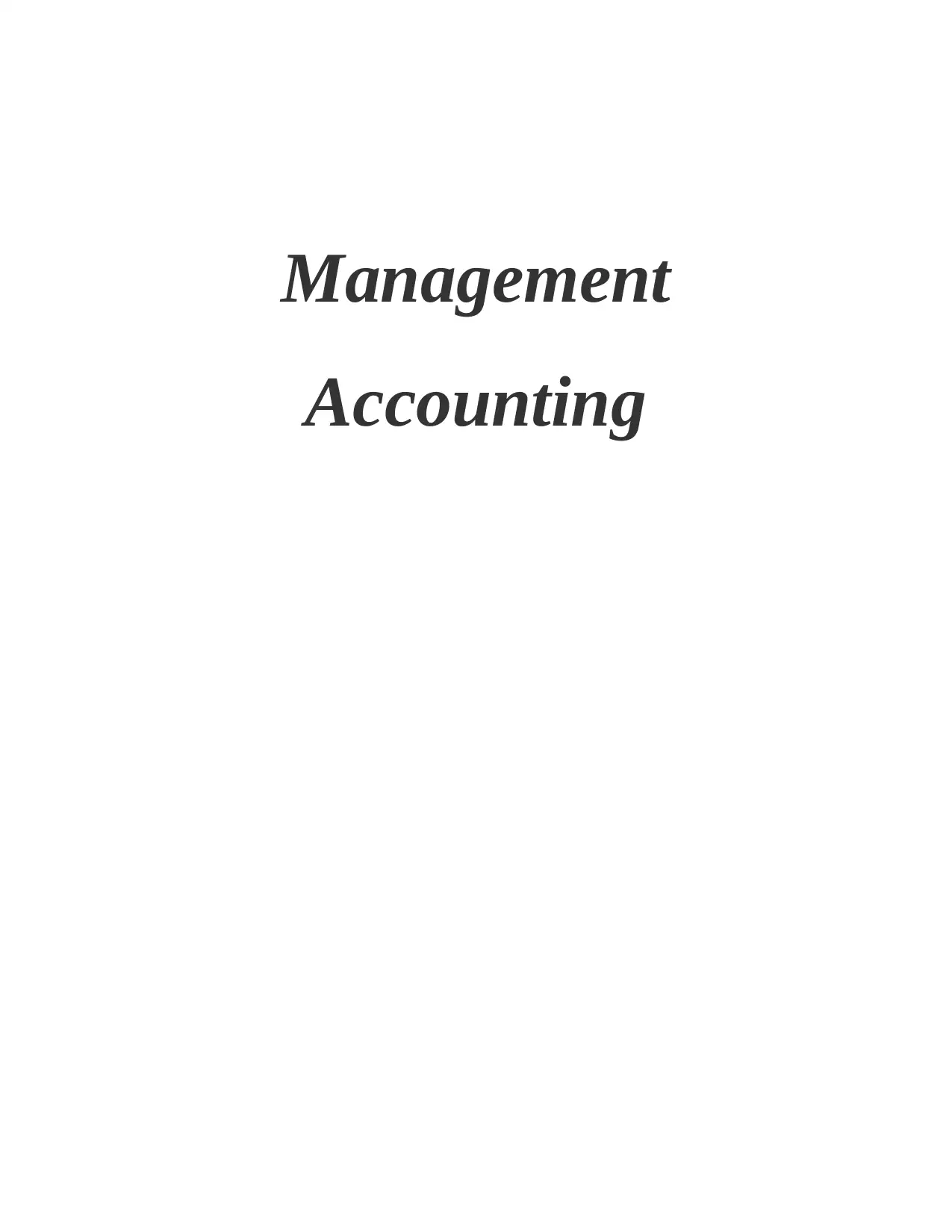
Management
Accounting
Accounting
Paraphrase This Document
Need a fresh take? Get an instant paraphrase of this document with our AI Paraphraser
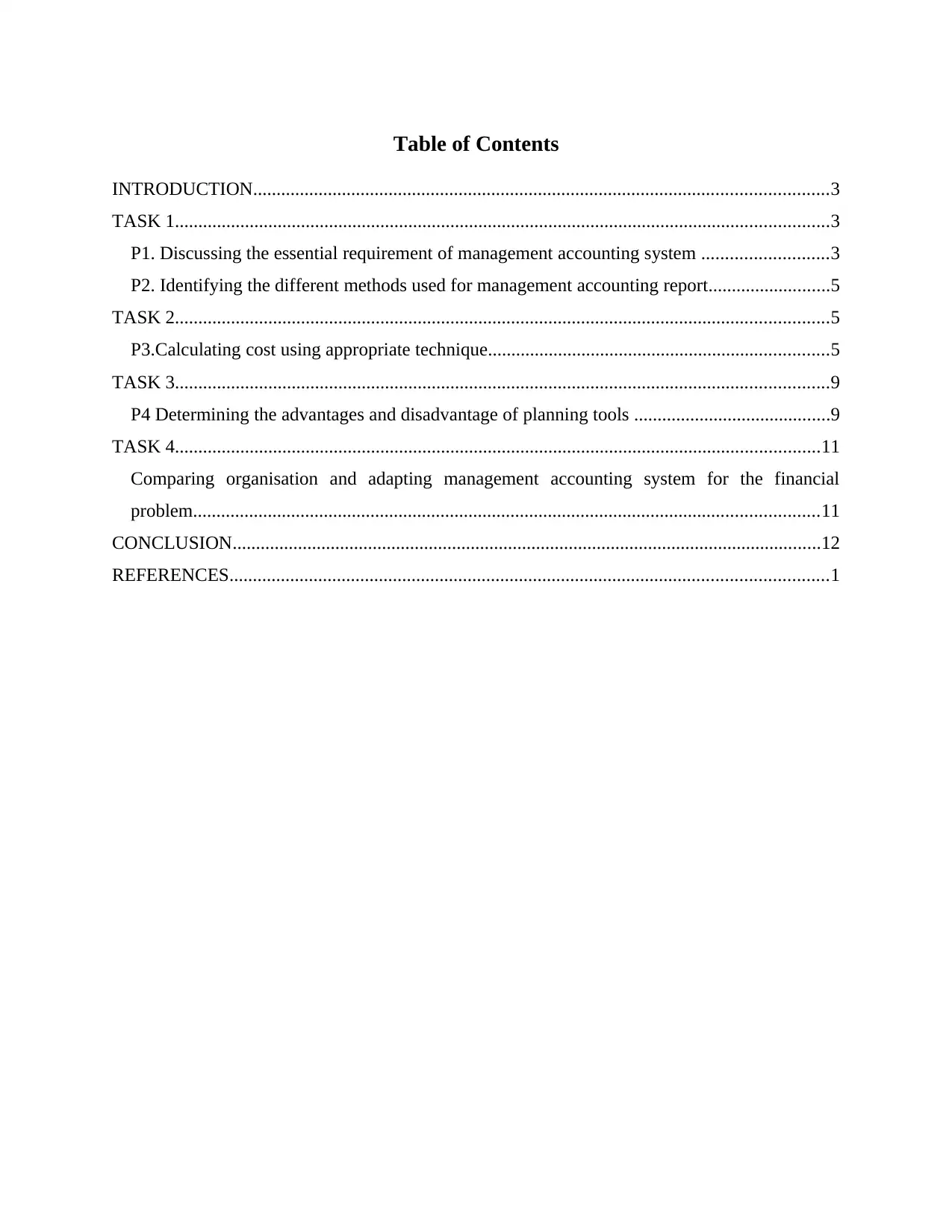
Table of Contents
INTRODUCTION...........................................................................................................................3
TASK 1............................................................................................................................................3
P1. Discussing the essential requirement of management accounting system ...........................3
P2. Identifying the different methods used for management accounting report..........................5
TASK 2............................................................................................................................................5
P3.Calculating cost using appropriate technique.........................................................................5
TASK 3............................................................................................................................................9
P4 Determining the advantages and disadvantage of planning tools ..........................................9
TASK 4..........................................................................................................................................11
Comparing organisation and adapting management accounting system for the financial
problem......................................................................................................................................11
CONCLUSION..............................................................................................................................12
REFERENCES................................................................................................................................1
INTRODUCTION...........................................................................................................................3
TASK 1............................................................................................................................................3
P1. Discussing the essential requirement of management accounting system ...........................3
P2. Identifying the different methods used for management accounting report..........................5
TASK 2............................................................................................................................................5
P3.Calculating cost using appropriate technique.........................................................................5
TASK 3............................................................................................................................................9
P4 Determining the advantages and disadvantage of planning tools ..........................................9
TASK 4..........................................................................................................................................11
Comparing organisation and adapting management accounting system for the financial
problem......................................................................................................................................11
CONCLUSION..............................................................................................................................12
REFERENCES................................................................................................................................1
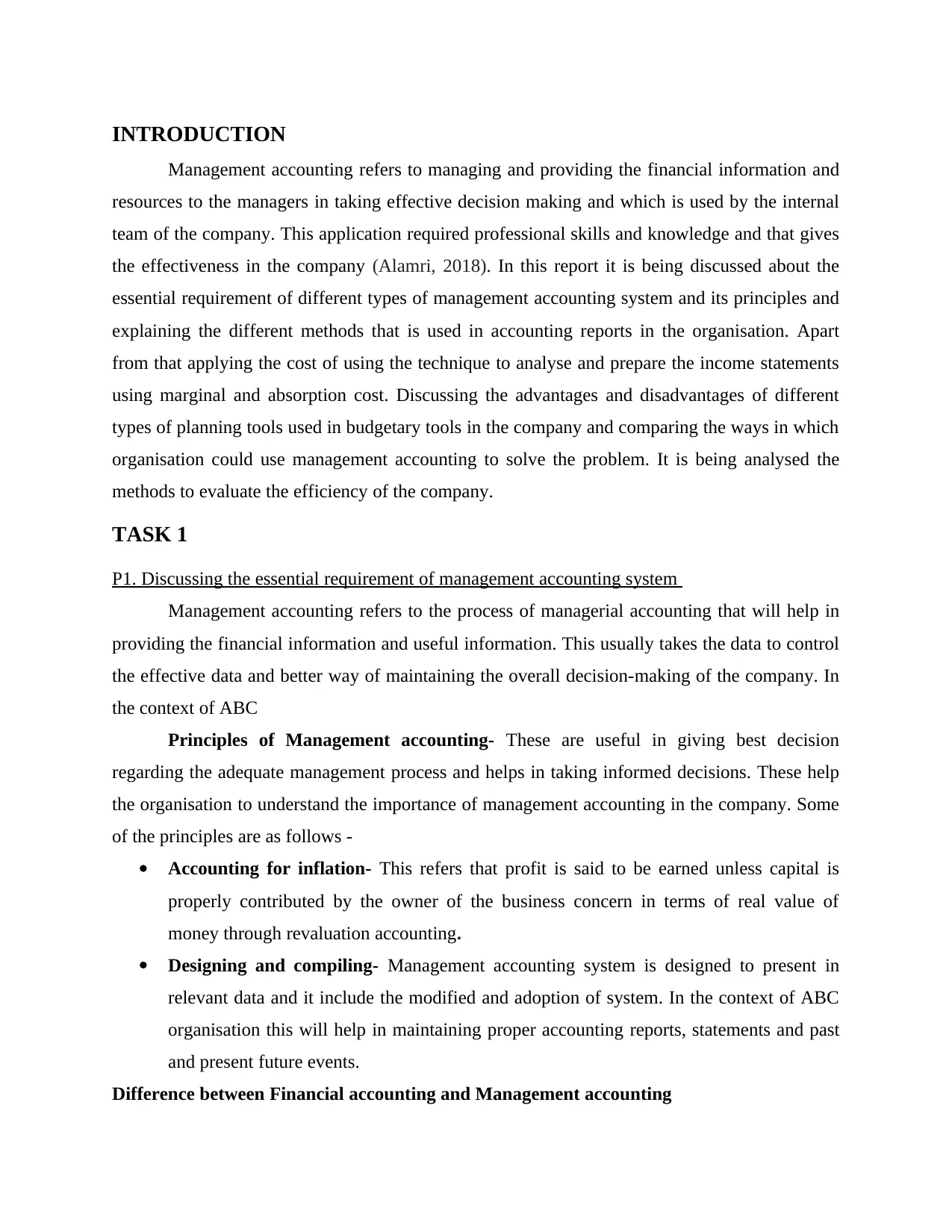
INTRODUCTION
Management accounting refers to managing and providing the financial information and
resources to the managers in taking effective decision making and which is used by the internal
team of the company. This application required professional skills and knowledge and that gives
the effectiveness in the company (Alamri, 2018). In this report it is being discussed about the
essential requirement of different types of management accounting system and its principles and
explaining the different methods that is used in accounting reports in the organisation. Apart
from that applying the cost of using the technique to analyse and prepare the income statements
using marginal and absorption cost. Discussing the advantages and disadvantages of different
types of planning tools used in budgetary tools in the company and comparing the ways in which
organisation could use management accounting to solve the problem. It is being analysed the
methods to evaluate the efficiency of the company.
TASK 1
P1. Discussing the essential requirement of management accounting system
Management accounting refers to the process of managerial accounting that will help in
providing the financial information and useful information. This usually takes the data to control
the effective data and better way of maintaining the overall decision-making of the company. In
the context of ABC
Principles of Management accounting- These are useful in giving best decision
regarding the adequate management process and helps in taking informed decisions. These help
the organisation to understand the importance of management accounting in the company. Some
of the principles are as follows -
Accounting for inflation- This refers that profit is said to be earned unless capital is
properly contributed by the owner of the business concern in terms of real value of
money through revaluation accounting.
Designing and compiling- Management accounting system is designed to present in
relevant data and it include the modified and adoption of system. In the context of ABC
organisation this will help in maintaining proper accounting reports, statements and past
and present future events.
Difference between Financial accounting and Management accounting
Management accounting refers to managing and providing the financial information and
resources to the managers in taking effective decision making and which is used by the internal
team of the company. This application required professional skills and knowledge and that gives
the effectiveness in the company (Alamri, 2018). In this report it is being discussed about the
essential requirement of different types of management accounting system and its principles and
explaining the different methods that is used in accounting reports in the organisation. Apart
from that applying the cost of using the technique to analyse and prepare the income statements
using marginal and absorption cost. Discussing the advantages and disadvantages of different
types of planning tools used in budgetary tools in the company and comparing the ways in which
organisation could use management accounting to solve the problem. It is being analysed the
methods to evaluate the efficiency of the company.
TASK 1
P1. Discussing the essential requirement of management accounting system
Management accounting refers to the process of managerial accounting that will help in
providing the financial information and useful information. This usually takes the data to control
the effective data and better way of maintaining the overall decision-making of the company. In
the context of ABC
Principles of Management accounting- These are useful in giving best decision
regarding the adequate management process and helps in taking informed decisions. These help
the organisation to understand the importance of management accounting in the company. Some
of the principles are as follows -
Accounting for inflation- This refers that profit is said to be earned unless capital is
properly contributed by the owner of the business concern in terms of real value of
money through revaluation accounting.
Designing and compiling- Management accounting system is designed to present in
relevant data and it include the modified and adoption of system. In the context of ABC
organisation this will help in maintaining proper accounting reports, statements and past
and present future events.
Difference between Financial accounting and Management accounting
⊘ This is a preview!⊘
Do you want full access?
Subscribe today to unlock all pages.

Trusted by 1+ million students worldwide

Basis Management accounting Financial accounting
Meaning This refers to managing and
controlling the financial
information to the managers to
take appropriate decision
making.
This is recording and
presentation of information for
the benefit of the various
stakeholder of the
organisation.
Purpose This is used by internal team
of the company.
This is used by the shareholder
and other investor of the
company.
Uses This basically effectively in
taking decision regarding
overall business process to
determine the growth.
This helps in analysing the
performance of the company
and useful for investor,
shareholder and competitors.
Types of management accounting system
The term management accounting system refers to providing information to the managers
regarding the assessment of different operational activities of the firm (Aureli, and et. al. 2019).
So that managers of ABC Ltd. can take important financial decisions for all operational
activities of the business. There are different types of management accounting system some of
them are explained below.
Cost accounting system
Cost accounting system is also called product costing system. This system helps the
management to estimate the price of the product to be produce. By measuring the estimated price
of the product company can evaluate the profit margin on the particular product. This method
also helps in calculating the cost of the production of the product.
Inventory management system
Inventory management system is a system which helps the company keeping an check on
it's inventory or goods. Evaluation of inventory may help the company in making decision
regarding the purchase of new industrial goods or raw material. This system can also be in
measuring the sales company have made and can make in the future. With the help of the results
Meaning This refers to managing and
controlling the financial
information to the managers to
take appropriate decision
making.
This is recording and
presentation of information for
the benefit of the various
stakeholder of the
organisation.
Purpose This is used by internal team
of the company.
This is used by the shareholder
and other investor of the
company.
Uses This basically effectively in
taking decision regarding
overall business process to
determine the growth.
This helps in analysing the
performance of the company
and useful for investor,
shareholder and competitors.
Types of management accounting system
The term management accounting system refers to providing information to the managers
regarding the assessment of different operational activities of the firm (Aureli, and et. al. 2019).
So that managers of ABC Ltd. can take important financial decisions for all operational
activities of the business. There are different types of management accounting system some of
them are explained below.
Cost accounting system
Cost accounting system is also called product costing system. This system helps the
management to estimate the price of the product to be produce. By measuring the estimated price
of the product company can evaluate the profit margin on the particular product. This method
also helps in calculating the cost of the production of the product.
Inventory management system
Inventory management system is a system which helps the company keeping an check on
it's inventory or goods. Evaluation of inventory may help the company in making decision
regarding the purchase of new industrial goods or raw material. This system can also be in
measuring the sales company have made and can make in the future. With the help of the results
Paraphrase This Document
Need a fresh take? Get an instant paraphrase of this document with our AI Paraphraser

from this system company can decide what goods should be purchased, when purchase should be
made and how much quantity of the product is actually needed.
Job-costing system
Job costing system includes the procedure of evaluating the cost which is occurred during
the production of particular product or service (Kalkhouran, Nedaei and Rasid, 2017). This
system can be very helpful while determining the price of an individual product or service,
because this system shows all the cost of raw material and other expenses made for the
production of that product.
Price optimization system
Price optimization/optimising system is the method which evaluates the demand of a
particular product in the market at different price levels. This system can provide an quite
accurate estimation of the profit which company can make on that particular product. Company
can use this system to fix the the prices of products which will increase company's profit.
P2. Identifying the different methods used for management accounting report
In the organisation, reports are useful in making essential report on the transaction which
is useful in taking decisions regarding many operational activities. In the ABC company, this
uses in overviewing the strategical analyses and provide necessary information. Followings\ are
as follows-
Job costing report- This is beneficial in analysing the per cost of every job is done and
useful in conducting the activities of job to give meaningful output to the firm. In the
context of ABC company this will help in comparing actual budget cost and helps the
manager to take right decisions (OTLEY, 2019).
Performance report- Business report is beneficial in handling the valuable output of the
organisation and gives best way to analyse the forecasting revenue and expenses for the
company. In the context of ABC company, this will help in measuring the performance of
employees and to achieve the desired objectives for the company.
TASK 2
P3.Calculating cost using appropriate technique
Cost refers to value of money that has been spent to produce something to deliver the
goods and services. This is like the expenses for the company and does not include mark-up for
made and how much quantity of the product is actually needed.
Job-costing system
Job costing system includes the procedure of evaluating the cost which is occurred during
the production of particular product or service (Kalkhouran, Nedaei and Rasid, 2017). This
system can be very helpful while determining the price of an individual product or service,
because this system shows all the cost of raw material and other expenses made for the
production of that product.
Price optimization system
Price optimization/optimising system is the method which evaluates the demand of a
particular product in the market at different price levels. This system can provide an quite
accurate estimation of the profit which company can make on that particular product. Company
can use this system to fix the the prices of products which will increase company's profit.
P2. Identifying the different methods used for management accounting report
In the organisation, reports are useful in making essential report on the transaction which
is useful in taking decisions regarding many operational activities. In the ABC company, this
uses in overviewing the strategical analyses and provide necessary information. Followings\ are
as follows-
Job costing report- This is beneficial in analysing the per cost of every job is done and
useful in conducting the activities of job to give meaningful output to the firm. In the
context of ABC company this will help in comparing actual budget cost and helps the
manager to take right decisions (OTLEY, 2019).
Performance report- Business report is beneficial in handling the valuable output of the
organisation and gives best way to analyse the forecasting revenue and expenses for the
company. In the context of ABC company, this will help in measuring the performance of
employees and to achieve the desired objectives for the company.
TASK 2
P3.Calculating cost using appropriate technique
Cost refers to value of money that has been spent to produce something to deliver the
goods and services. This is like the expenses for the company and does not include mark-up for
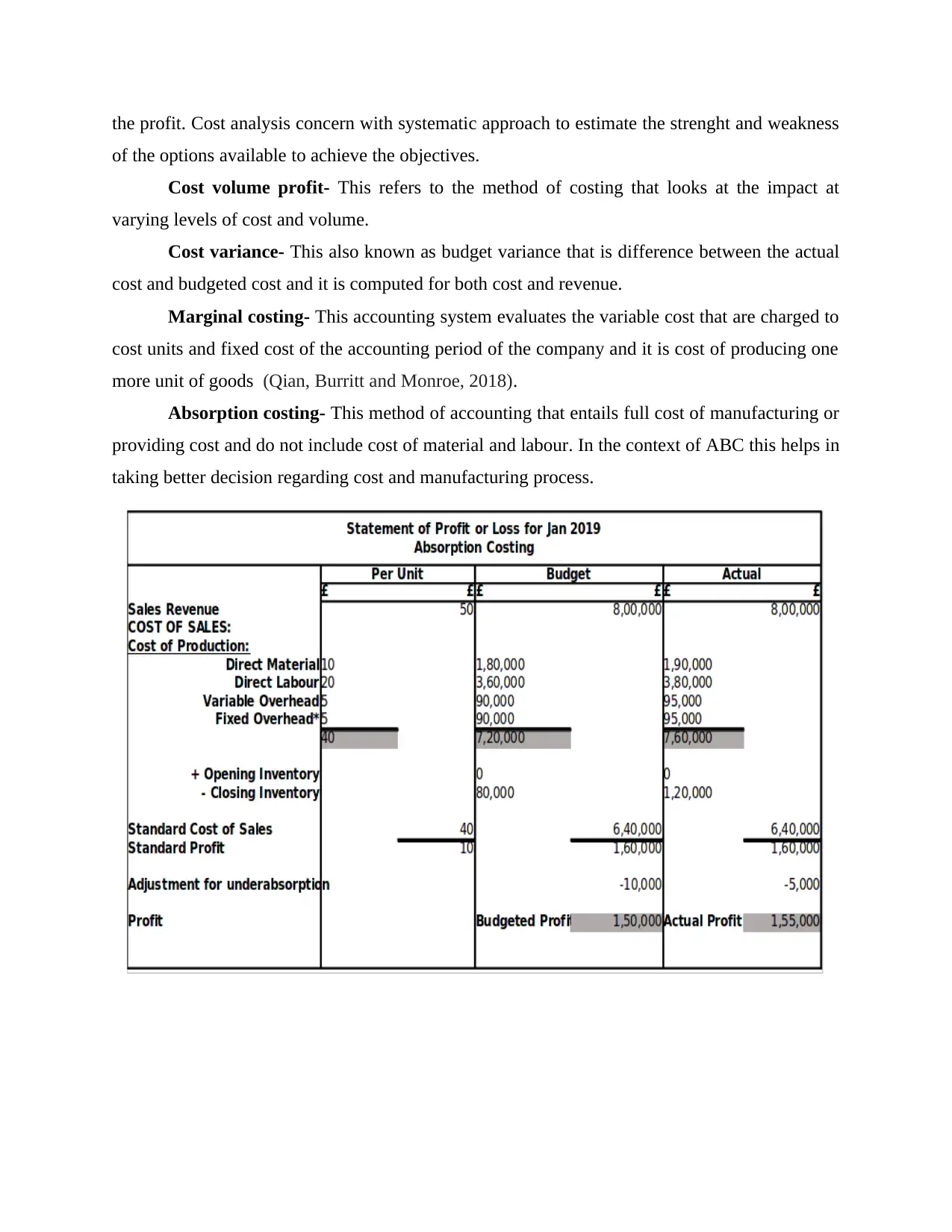
the profit. Cost analysis concern with systematic approach to estimate the strenght and weakness
of the options available to achieve the objectives.
Cost volume profit- This refers to the method of costing that looks at the impact at
varying levels of cost and volume.
Cost variance- This also known as budget variance that is difference between the actual
cost and budgeted cost and it is computed for both cost and revenue.
Marginal costing- This accounting system evaluates the variable cost that are charged to
cost units and fixed cost of the accounting period of the company and it is cost of producing one
more unit of goods (Qian, Burritt and Monroe, 2018).
Absorption costing- This method of accounting that entails full cost of manufacturing or
providing cost and do not include cost of material and labour. In the context of ABC this helps in
taking better decision regarding cost and manufacturing process.
of the options available to achieve the objectives.
Cost volume profit- This refers to the method of costing that looks at the impact at
varying levels of cost and volume.
Cost variance- This also known as budget variance that is difference between the actual
cost and budgeted cost and it is computed for both cost and revenue.
Marginal costing- This accounting system evaluates the variable cost that are charged to
cost units and fixed cost of the accounting period of the company and it is cost of producing one
more unit of goods (Qian, Burritt and Monroe, 2018).
Absorption costing- This method of accounting that entails full cost of manufacturing or
providing cost and do not include cost of material and labour. In the context of ABC this helps in
taking better decision regarding cost and manufacturing process.
⊘ This is a preview!⊘
Do you want full access?
Subscribe today to unlock all pages.

Trusted by 1+ million students worldwide
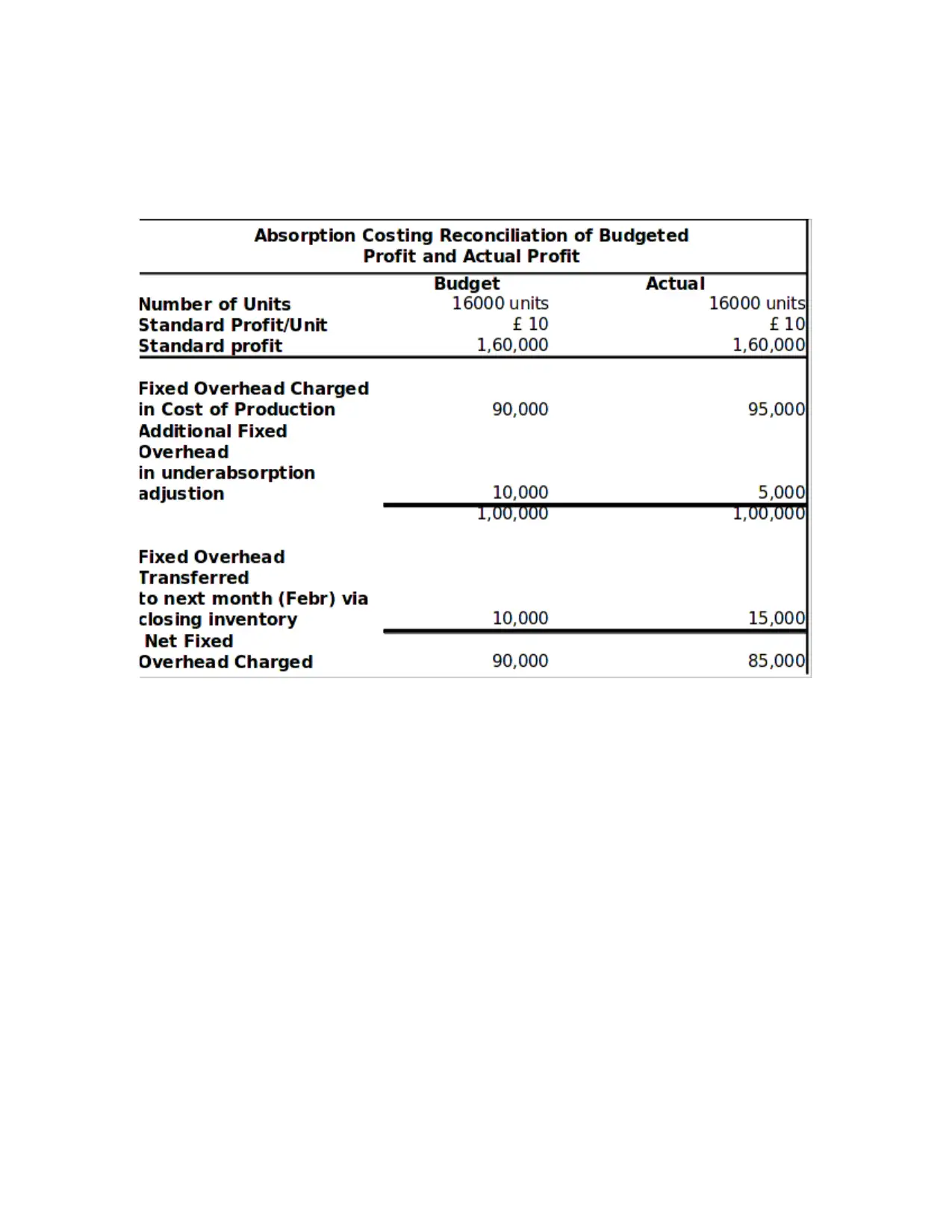
Paraphrase This Document
Need a fresh take? Get an instant paraphrase of this document with our AI Paraphraser

Product costing:
Fixed and variable cost- In the organisation the fixed cost refers to the number of goods
or services a company produces over short-term. Variable cost refers to the fluctuate as level of
production output changes in terms of fixed cost.
Cost allocation- This is the distribution of cost across the multiple entities, business units
and cost centre and in terms of cost centre this provide product and services.
Standard costing- It refers to the cost that not actually occurred and basically based on
the past year information of accounting.
Normal costing- This type of cost that incurred in order to complete the operational
activities and other important functions of the company (Van der Stede, 2017).
Role of costing in setting price- Costing generally plays important role in setting the
price of products and services that include the profit margin in the total cost of production. For
example, in the context of ABC Limited company, cost of particular unit 20 pound then price
will be 25 pound and price set by adding 5 in their actual production cost.
Fixed and variable cost- In the organisation the fixed cost refers to the number of goods
or services a company produces over short-term. Variable cost refers to the fluctuate as level of
production output changes in terms of fixed cost.
Cost allocation- This is the distribution of cost across the multiple entities, business units
and cost centre and in terms of cost centre this provide product and services.
Standard costing- It refers to the cost that not actually occurred and basically based on
the past year information of accounting.
Normal costing- This type of cost that incurred in order to complete the operational
activities and other important functions of the company (Van der Stede, 2017).
Role of costing in setting price- Costing generally plays important role in setting the
price of products and services that include the profit margin in the total cost of production. For
example, in the context of ABC Limited company, cost of particular unit 20 pound then price
will be 25 pound and price set by adding 5 in their actual production cost.

Inventory cost- It relates that types of expenses that play important role in working
capital requirement of the business and plan cash flow of the cycle. Types of inventory cost are
as follows-
Ordering cost- This include the wages that related payroll tax and other benefits that
ensure the labour cost to the supplier that helps in allocating the units.
Holding cost- This refers to space that hold the inventory that include the risk of loss and
any other threats (Wilkerson and Bassani, 2020). In the company this help in
understanding the cost of space, cost of money and cost of obsolescence.
The benefit of reducing the inventory cost to organisation will lead to certain benefits such as
improving in profit margin and enhancing in productivity.
Valuation Method
LIFO Method- This refers to the Last in, this applies to the non-perishable goods that
used in current prices to calculate cost of goods sold.
FIFO Method- This concern with first in, first out in the inventory management that
seeks to sell older products first and business is less likely to lose the money when
products expire or become obsolete in period of time.
Cost variance- This is difference between the cost that actually incurred and budgeted or
planned amount of cost that need to be incurred and this mostly used to track the expenses.
Overhead cost- This cost is ongoing cost that operates business but does not include direct cost
that is associated with creating product or services and it reports to the income statements.
TASK 3
P4 Determining the advantages and disadvantage of planning tools
Budgets concern with estimation of income and expenses that incurred while running the
organisation and useful in determining the effectiveness of the organisation. In the context of
ABC company this helps in managing of all activities under the control. Some of the budgets are
as follows-
Capital budget- This budget refers to the way of investment and regulating long-term
expenses that arises in the company while operating the business activities. This budget used by
the company that used in many ways and methods.
capital requirement of the business and plan cash flow of the cycle. Types of inventory cost are
as follows-
Ordering cost- This include the wages that related payroll tax and other benefits that
ensure the labour cost to the supplier that helps in allocating the units.
Holding cost- This refers to space that hold the inventory that include the risk of loss and
any other threats (Wilkerson and Bassani, 2020). In the company this help in
understanding the cost of space, cost of money and cost of obsolescence.
The benefit of reducing the inventory cost to organisation will lead to certain benefits such as
improving in profit margin and enhancing in productivity.
Valuation Method
LIFO Method- This refers to the Last in, this applies to the non-perishable goods that
used in current prices to calculate cost of goods sold.
FIFO Method- This concern with first in, first out in the inventory management that
seeks to sell older products first and business is less likely to lose the money when
products expire or become obsolete in period of time.
Cost variance- This is difference between the cost that actually incurred and budgeted or
planned amount of cost that need to be incurred and this mostly used to track the expenses.
Overhead cost- This cost is ongoing cost that operates business but does not include direct cost
that is associated with creating product or services and it reports to the income statements.
TASK 3
P4 Determining the advantages and disadvantage of planning tools
Budgets concern with estimation of income and expenses that incurred while running the
organisation and useful in determining the effectiveness of the organisation. In the context of
ABC company this helps in managing of all activities under the control. Some of the budgets are
as follows-
Capital budget- This budget refers to the way of investment and regulating long-term
expenses that arises in the company while operating the business activities. This budget used by
the company that used in many ways and methods.
⊘ This is a preview!⊘
Do you want full access?
Subscribe today to unlock all pages.

Trusted by 1+ million students worldwide
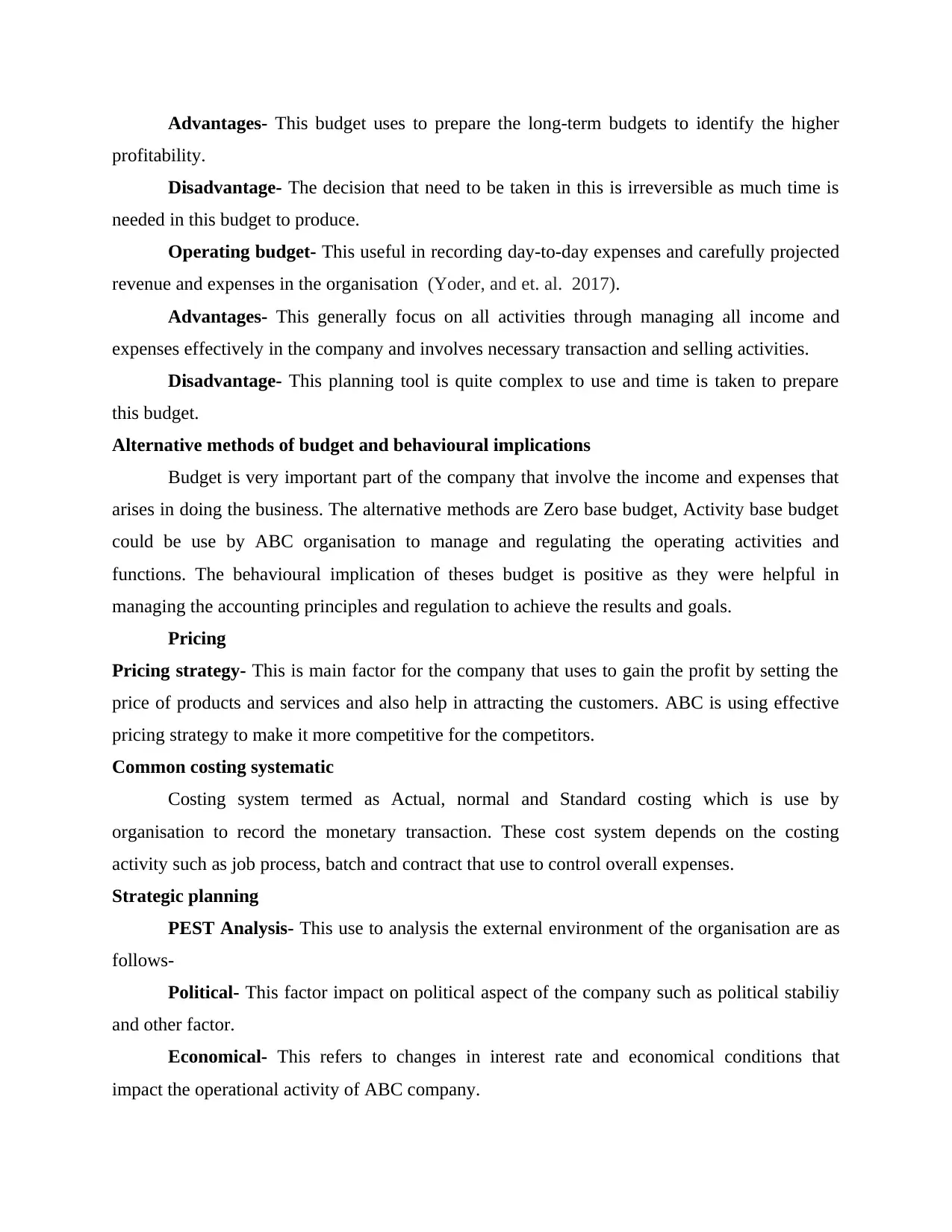
Advantages- This budget uses to prepare the long-term budgets to identify the higher
profitability.
Disadvantage- The decision that need to be taken in this is irreversible as much time is
needed in this budget to produce.
Operating budget- This useful in recording day-to-day expenses and carefully projected
revenue and expenses in the organisation (Yoder, and et. al. 2017).
Advantages- This generally focus on all activities through managing all income and
expenses effectively in the company and involves necessary transaction and selling activities.
Disadvantage- This planning tool is quite complex to use and time is taken to prepare
this budget.
Alternative methods of budget and behavioural implications
Budget is very important part of the company that involve the income and expenses that
arises in doing the business. The alternative methods are Zero base budget, Activity base budget
could be use by ABC organisation to manage and regulating the operating activities and
functions. The behavioural implication of theses budget is positive as they were helpful in
managing the accounting principles and regulation to achieve the results and goals.
Pricing
Pricing strategy- This is main factor for the company that uses to gain the profit by setting the
price of products and services and also help in attracting the customers. ABC is using effective
pricing strategy to make it more competitive for the competitors.
Common costing systematic
Costing system termed as Actual, normal and Standard costing which is use by
organisation to record the monetary transaction. These cost system depends on the costing
activity such as job process, batch and contract that use to control overall expenses.
Strategic planning
PEST Analysis- This use to analysis the external environment of the organisation are as
follows-
Political- This factor impact on political aspect of the company such as political stabiliy
and other factor.
Economical- This refers to changes in interest rate and economical conditions that
impact the operational activity of ABC company.
profitability.
Disadvantage- The decision that need to be taken in this is irreversible as much time is
needed in this budget to produce.
Operating budget- This useful in recording day-to-day expenses and carefully projected
revenue and expenses in the organisation (Yoder, and et. al. 2017).
Advantages- This generally focus on all activities through managing all income and
expenses effectively in the company and involves necessary transaction and selling activities.
Disadvantage- This planning tool is quite complex to use and time is taken to prepare
this budget.
Alternative methods of budget and behavioural implications
Budget is very important part of the company that involve the income and expenses that
arises in doing the business. The alternative methods are Zero base budget, Activity base budget
could be use by ABC organisation to manage and regulating the operating activities and
functions. The behavioural implication of theses budget is positive as they were helpful in
managing the accounting principles and regulation to achieve the results and goals.
Pricing
Pricing strategy- This is main factor for the company that uses to gain the profit by setting the
price of products and services and also help in attracting the customers. ABC is using effective
pricing strategy to make it more competitive for the competitors.
Common costing systematic
Costing system termed as Actual, normal and Standard costing which is use by
organisation to record the monetary transaction. These cost system depends on the costing
activity such as job process, batch and contract that use to control overall expenses.
Strategic planning
PEST Analysis- This use to analysis the external environment of the organisation are as
follows-
Political- This factor impact on political aspect of the company such as political stabiliy
and other factor.
Economical- This refers to changes in interest rate and economical conditions that
impact the operational activity of ABC company.
Paraphrase This Document
Need a fresh take? Get an instant paraphrase of this document with our AI Paraphraser
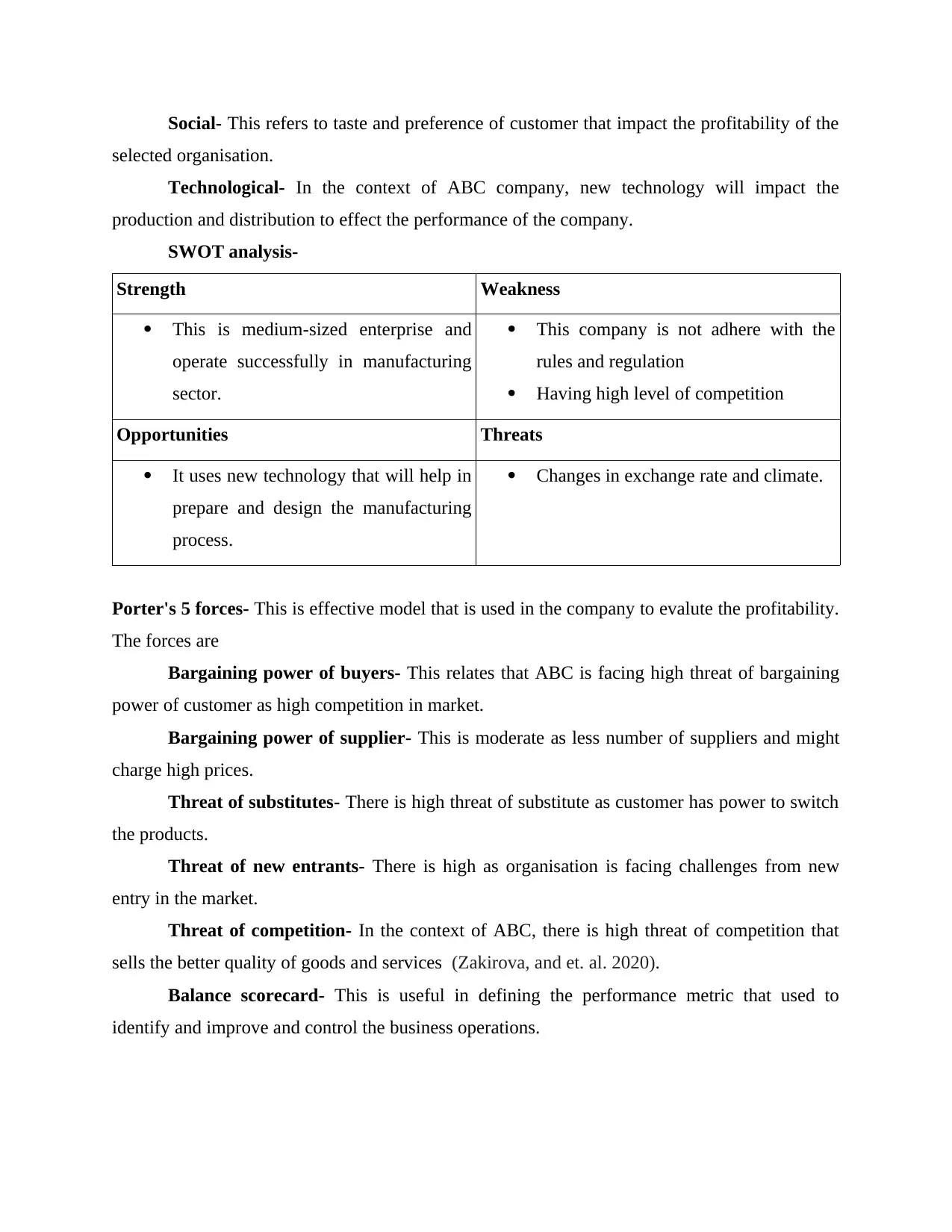
Social- This refers to taste and preference of customer that impact the profitability of the
selected organisation.
Technological- In the context of ABC company, new technology will impact the
production and distribution to effect the performance of the company.
SWOT analysis-
Strength Weakness
This is medium-sized enterprise and
operate successfully in manufacturing
sector.
This company is not adhere with the
rules and regulation
Having high level of competition
Opportunities Threats
It uses new technology that will help in
prepare and design the manufacturing
process.
Changes in exchange rate and climate.
Porter's 5 forces- This is effective model that is used in the company to evalute the profitability.
The forces are
Bargaining power of buyers- This relates that ABC is facing high threat of bargaining
power of customer as high competition in market.
Bargaining power of supplier- This is moderate as less number of suppliers and might
charge high prices.
Threat of substitutes- There is high threat of substitute as customer has power to switch
the products.
Threat of new entrants- There is high as organisation is facing challenges from new
entry in the market.
Threat of competition- In the context of ABC, there is high threat of competition that
sells the better quality of goods and services (Zakirova, and et. al. 2020).
Balance scorecard- This is useful in defining the performance metric that used to
identify and improve and control the business operations.
selected organisation.
Technological- In the context of ABC company, new technology will impact the
production and distribution to effect the performance of the company.
SWOT analysis-
Strength Weakness
This is medium-sized enterprise and
operate successfully in manufacturing
sector.
This company is not adhere with the
rules and regulation
Having high level of competition
Opportunities Threats
It uses new technology that will help in
prepare and design the manufacturing
process.
Changes in exchange rate and climate.
Porter's 5 forces- This is effective model that is used in the company to evalute the profitability.
The forces are
Bargaining power of buyers- This relates that ABC is facing high threat of bargaining
power of customer as high competition in market.
Bargaining power of supplier- This is moderate as less number of suppliers and might
charge high prices.
Threat of substitutes- There is high threat of substitute as customer has power to switch
the products.
Threat of new entrants- There is high as organisation is facing challenges from new
entry in the market.
Threat of competition- In the context of ABC, there is high threat of competition that
sells the better quality of goods and services (Zakirova, and et. al. 2020).
Balance scorecard- This is useful in defining the performance metric that used to
identify and improve and control the business operations.
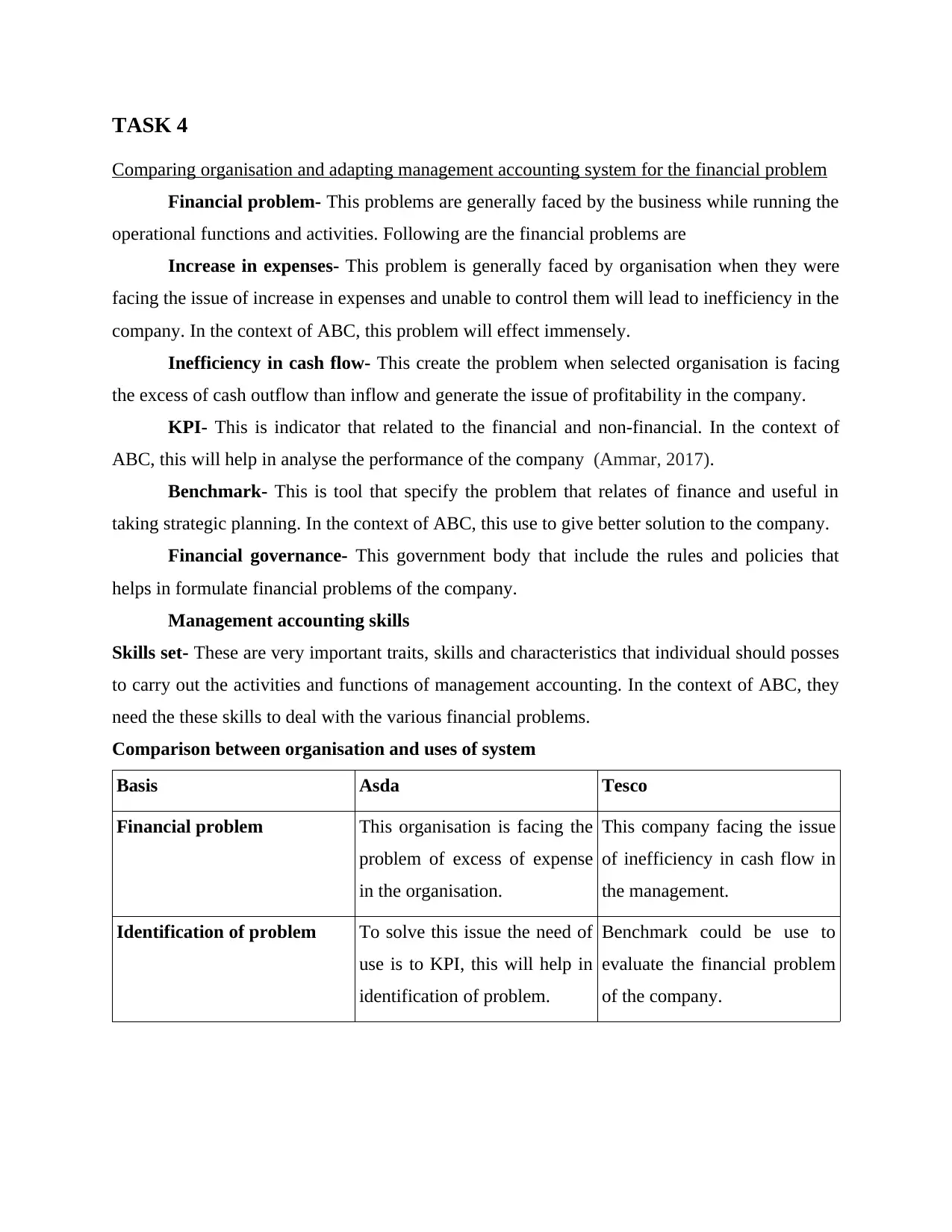
TASK 4
Comparing organisation and adapting management accounting system for the financial problem
Financial problem- This problems are generally faced by the business while running the
operational functions and activities. Following are the financial problems are
Increase in expenses- This problem is generally faced by organisation when they were
facing the issue of increase in expenses and unable to control them will lead to inefficiency in the
company. In the context of ABC, this problem will effect immensely.
Inefficiency in cash flow- This create the problem when selected organisation is facing
the excess of cash outflow than inflow and generate the issue of profitability in the company.
KPI- This is indicator that related to the financial and non-financial. In the context of
ABC, this will help in analyse the performance of the company (Ammar, 2017).
Benchmark- This is tool that specify the problem that relates of finance and useful in
taking strategic planning. In the context of ABC, this use to give better solution to the company.
Financial governance- This government body that include the rules and policies that
helps in formulate financial problems of the company.
Management accounting skills
Skills set- These are very important traits, skills and characteristics that individual should posses
to carry out the activities and functions of management accounting. In the context of ABC, they
need the these skills to deal with the various financial problems.
Comparison between organisation and uses of system
Basis Asda Tesco
Financial problem This organisation is facing the
problem of excess of expense
in the organisation.
This company facing the issue
of inefficiency in cash flow in
the management.
Identification of problem To solve this issue the need of
use is to KPI, this will help in
identification of problem.
Benchmark could be use to
evaluate the financial problem
of the company.
Comparing organisation and adapting management accounting system for the financial problem
Financial problem- This problems are generally faced by the business while running the
operational functions and activities. Following are the financial problems are
Increase in expenses- This problem is generally faced by organisation when they were
facing the issue of increase in expenses and unable to control them will lead to inefficiency in the
company. In the context of ABC, this problem will effect immensely.
Inefficiency in cash flow- This create the problem when selected organisation is facing
the excess of cash outflow than inflow and generate the issue of profitability in the company.
KPI- This is indicator that related to the financial and non-financial. In the context of
ABC, this will help in analyse the performance of the company (Ammar, 2017).
Benchmark- This is tool that specify the problem that relates of finance and useful in
taking strategic planning. In the context of ABC, this use to give better solution to the company.
Financial governance- This government body that include the rules and policies that
helps in formulate financial problems of the company.
Management accounting skills
Skills set- These are very important traits, skills and characteristics that individual should posses
to carry out the activities and functions of management accounting. In the context of ABC, they
need the these skills to deal with the various financial problems.
Comparison between organisation and uses of system
Basis Asda Tesco
Financial problem This organisation is facing the
problem of excess of expense
in the organisation.
This company facing the issue
of inefficiency in cash flow in
the management.
Identification of problem To solve this issue the need of
use is to KPI, this will help in
identification of problem.
Benchmark could be use to
evaluate the financial problem
of the company.
⊘ This is a preview!⊘
Do you want full access?
Subscribe today to unlock all pages.

Trusted by 1+ million students worldwide
1 out of 14
Related Documents
Your All-in-One AI-Powered Toolkit for Academic Success.
+13062052269
info@desklib.com
Available 24*7 on WhatsApp / Email
![[object Object]](/_next/static/media/star-bottom.7253800d.svg)
Unlock your academic potential
Copyright © 2020–2025 A2Z Services. All Rights Reserved. Developed and managed by ZUCOL.





